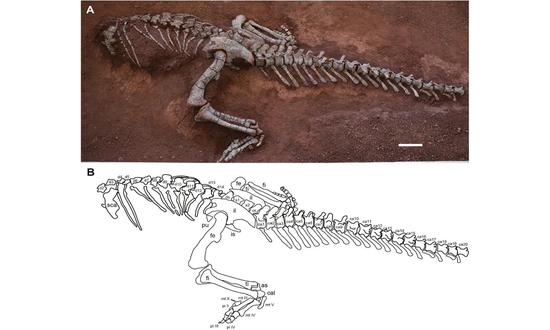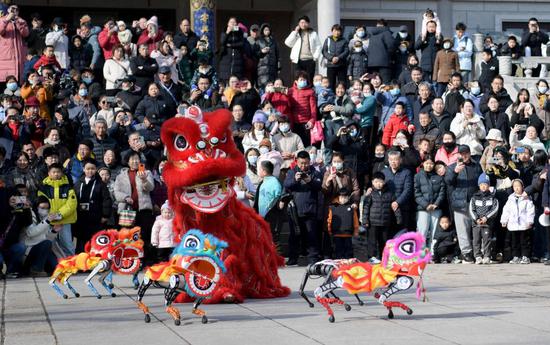
Skeleton fossils and sketches of Xingxiulong yueorum (Photo/Courtesy of the Institute of Vertebrate Paleontology and Paleoanthropology)
A new species of the early-diverging sauropodomorph Xingxiulong from the Lower Jurassic Lufeng Formation is erected on the basis of a postcranial skeleton in the city of Lufeng, Southwest China's Yunnan Province, according to a research paper recently published in Historical Biology, an international journal.
The Xingxiulong yueorum, sp. nov. is distinguished from the Xingxiulong chengi by possessing a pendant-shaped fourth trochanter with distal termination, an astragalus with almost straight dorsal margin of the posterior surface, and pedal digit V with two phalanges, said the paper.
This discovery adds to the diversity of the sauropodomorphs from the Lufeng formation and contributes to our understanding of the intricate patterns characterizing the early evolution of sauropodomorphs in Asia, said You Hailu, lead research fellow of the Institute of Vertebrate Paleontology and Paleoanthropology, Chinese Academy of Sciences.
A phylogenetic analysis supports the monophyly of genus Xingxiulong. Both the two species of Xingxiulong have four sacral vertebrae, which are typically associated with the late-diverging sauropodiforms and sauropods, suggesting a complex early evolution within the sauropodomorphs.
The Lufeng formation is one of the most important sedimentary units for understanding the evolution of the Early Jurassic sauropodomorph dinosaurs.
Named in 2017, the Xingxiulong species belongs to the Lower Jurassic period and shares some similarities with the previously discovered Xingxiulong chengi, such as having four sacral vertebrae.
Scientists have discovered that Xingxiulong yueorum has its own unique features, including a flat dorsal edge of the astragalus and two ossified phalanges on the fifth toe.
Meanwhile, the Xingxiulong yueorum appears to be larger, with an estimated length of 8 to 10 meters, longer than previous species Xingxiulong chengi, which measures 4 to 5 meters long.
The fossil specimen of Xingxiulong yueorum was discovered in 2015. It is currently stored in a small exhibition hall built on the site. The fossil specimen is a relatively well-preserved backbone of the head, preserving the complete sequence from the second dorsal vertebra to the twentieth tail vertebra, as well as the left scapula and an almost complete elements of pelvic and hind limbs.


















































 京公網安備 11010202009201號
京公網安備 11010202009201號